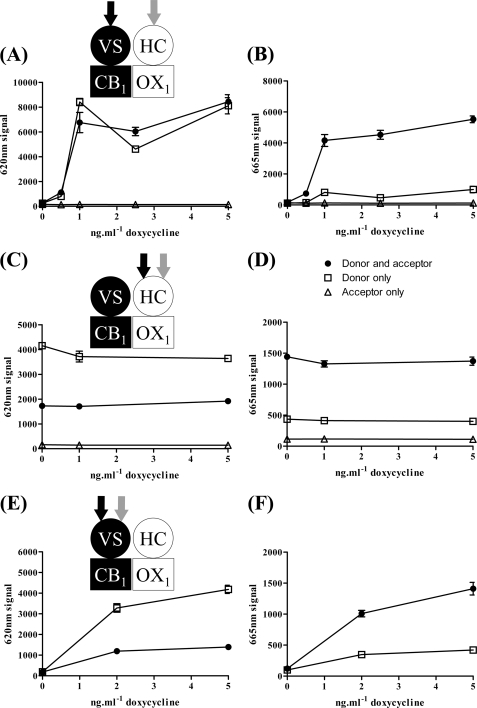FIGURE 7.
htrFRET detects each of cell surface CB1-OX1 receptor heteromultimers, CB1-CB1 homomers, and OX1-OX1 homomers. Cells of clone B6 were untreated or treated for 24 h with varying concentrations of doxycycline to induce VSV-G-SNAP-CB1 expression. A and B, SNAP-Lumi4Tb (donor alone; open squares) (to label VSV-G-SNAP-CB1), CLIP-Red (acceptor alone; open triangles) (to label HA-CLIP-OX1), or an optimal mixture (10 nm SNAP-Lumi4Tb and 350 nm CLIP-Red) (see supplemental Fig. 3) of SNAP-Lumi4Tb and CLIP-Red (filled circles) (to allow detection of potential CB1-OX1 heteromers) was added. In A, the signal at 620 nm (as a measure of VSV-G-SNAP-CB1 expression) was assessed. In B, the signal at 665 nm (as a measure of heteromer detection) was assessed. C–F, equivalent studies explored OX1-OX1 interactions (C and D) via separate addition of CLIP-Lumi4Tb (open squares) or CLIP-Red (open triangles) or their co-addition (filled circles) and CB1-CB1 interactions (E and F) via separate addition of SNAP-Lumi4Tb (open squares) or co-addition of SNAP-Lumi4Tb and SNAP-Red (filled circles). Data are means ± S.E. (n = 3). VS, VSV-G + SNAP tag; HC, HA + CLIP tag.

